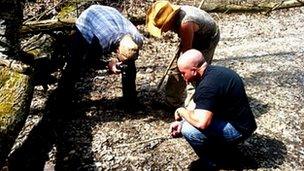On the trail with Bigfoot-hunters
- Published
- comments
Not since footage emerged of a giant, ape-like figure in the California woods in the late 1960s has there been so much interest in proving the existence of Bigfoot. So how do you go about finding a creature most people believe to be a myth?
It could be a human footprint. Let's not rule that out.
Kentucky Bigfoot investigators pride themselves on their scientific rigour.
They compile detailed reports, take copious notes, and rely on high-tech recording equipment to set their traps and document their work.
Every twisted branch or broken twig is carefully examined for clues. Every distant sound in the trees seized on as a possible sign of "activity".
Footprint
Which is how I came to be standing on the bank of a stream on a warm spring day staring at an indentation in the shingle.

Bigfoot is notoriously camera shy - but there are plenty of artists' impressions
Someone had pointed it out as a potential footprint. It was certainly big enough. Maybe even too big.
But as Charlie, our team leader, got to work with a tape measure, I assured myself that it was probably human.
And that's when I knew they had got me. Probably is not a word I would have used a few hours ago, when we set out.
Back then I would have said it was definitely human. But back then my scepticism was impregnable. Now it was starting to fray at the edges.
Maybe this is how it starts.
Yahoo-hunting
People have reported seeing strange, ape-like creatures in the forests of North America for centuries.

It's big and it was apparently made by a foot - but is it Bigfoot?
Frontiersman Daniel Boone is meant to have shot and killed one of them. He dubbed the 2.5-m (8.2-ft) tall beast a Yahoo, after the creatures in Jonathan Swift's classic novel Gulliver's Travels.
The Yahoo's descendants have come to be known as Bigfoot in some circles, Sasquatch in others. Whatever you call it, it is currently big news. YouTube is awash with "sightings". Most of them are obvious fakes.
But what has really given new life to a very old legend is reality TV and its remorseless appetite for eccentric characters.
It seems like every Sasquatch-spotter, from Canada to the Florida Keys, is in talks with a production company or has already been featured in a reality show of his own.
Life-changing encounter
When a TV crew arrives with a list of pre-planned shots and outlandish things for them to say, the Bigfoot-hunters generally play along.
They know they are being held up to mockery, on some level, but they seem to be in little doubt about Bigfoot's existence.
Joy, a middle-aged healthcare consultant, is the lead investigator with the Kentucky Bigfoot Research Organization.
She says she saw Bigfoot for the first time last autumn. Or, rather, it saw her.
As she was changing out of some wet clothes on a camping trip, she became aware of a hairy male face peeping at her under the tent flap, she told me.
According to Joy, there was an overpowering odour. And she heard a low, guttural grunt. Whatever the creature staring at her was, it was not human.
Joy's boyfriend, Ben, smiled as she told her tale. He is a Bigfoot sceptic - but it's a good excuse for a hike in the woods.
Some native American tribes in the north-west of America believe the Sasquatch is real. Most think of him as a spiritual being, whose appearance before man is meant to convey some kind of message.
One member of the Kentucky group told me he also thinks Bigfoot could be a spiritual manifestation.
Bart Nunnelly has written several books on the mythical creatures that he believes live in the Kentucky forests.
When he was nine, his family told a local newspaper they were being terrorised by giant ape-like creatures.
He has been the subject of ridicule ever since.
After all, there is little conclusive proof that Bigfoot is anything but a myth. Despite their emphasis on scientific fact, the majority of the group's evidence comes in the form of anecdotal bigfoot sightings collected on their website.
The footprint we found, they decided, was most likely human.
But Mr Nunnelly, like all the Bigfoot devotees I met in Kentucky, is not worried about the mockery of sceptics and non-believers.
He seems certain about what he has seen, and that it wasn't human.